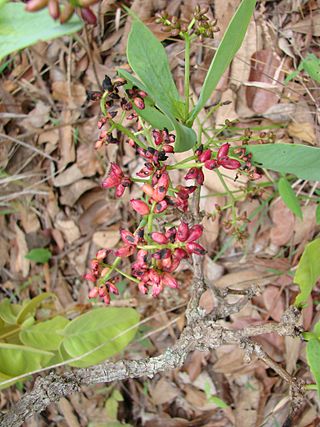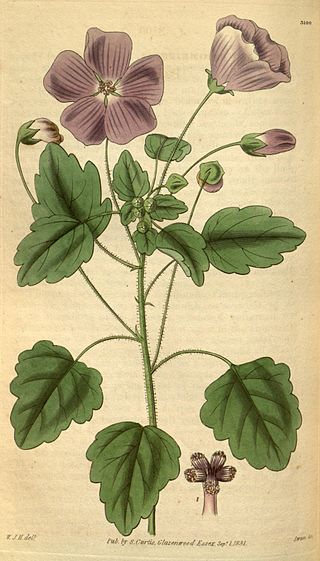
Dieffenbachia, commonly known as dumb caneorleopard lily, is a genus of tropical flowering plants in the family Araceae. It is native to the New World Tropics from Mexico and the West Indies south to Argentina. Some species are widely cultivated as ornamental plants, especially as houseplants, and have become naturalized on a few tropical islands.

Prumnopitys andina, the lleuque or Chilean plum yew, is an evergreen coniferous tree native to south-central Chile and a few areas in adjacent parts of westernmost Argentina from 36 to 40° South latitude. It lives on moderately wet soils, preferably on Andean slopes from 500–1,100 meters (1,600–3,600 ft).

Gaultheria is a genus of about 135 species of shrubs in the family Ericaceae. The name commemorates Jean François Gaultier of Quebec, an honour bestowed by the Scandinavian Pehr Kalm in 1748 and taken up by Carl Linnaeus in his Species Plantarum. These plants are native to Asia, Australasia and North and South America. In the past, the Southern Hemisphere species were often treated as the separate genus Pernettya, but no consistent reliable morphological or genetic differences support recognition of two genera, and they are now united in the single genus Gaultheria.

Apium is a genus of about 20 species of flowering plants in the family Apiaceae, with a subcosmopolitan distribution in Europe, Asia, Africa, South America and Australia. They are medium to tall biennials or perennials growing up to 1 m high in the wet soil of marshes and salt marshes, and have pinnate to bipinnate leaves and small white flowers in compound umbels. Some species are edible, notably Apium graveolens, which includes the commercially important vegetables celery, celeriac and Chinese celery. Apium bermejoi from the island of Menorca is one of the rarest plants in Europe, with fewer than 100 individuals left.

Haplopappus is a genus of flowering plants in the family Asteraceae found in South America, mostly restricted to the dry regions of the Southern Andes, Chilean Matorral, and Patagonia.

Mutisia is a genus of flowering plant in the tribe Mutisieae within the family Asteraceae. Mutisia has been named after José Celestino Mutis. It comprises about sixty species which can be found along the entire length of the Andes and in southern Brazil, Paraguay, Uruguay and northern Argentina.

Helicostylis is a genus of plants in the family Moraceae.

Neea is a genus of plants in family Nyctaginaceae from the Caribbean region, Central and South America. Members of the genus are commonly called Nia, Neea, or saltwood.

Palaua is a genus of malvaceous plants native to the Andes. It shares with Malope and Kitaibelia the property of possessing capitate schizocarps, and was formerly classified with them in a subfamily Malopoideae or tribe Malopeae. It is now considered to be more closely related to Sphaeralcea, and to other Andean mallows.

Karl Friedrich Reiche was a German botanist who worked as a university professor in Chile and Mexico.

Nassauvia is a genus of flowering plants in the tribe Nassauvieae within the family Asteraceae. It is native to Argentina, Bolivia, Chile and the Falkland Islands.

Anarthrophyllum is a genus of flowering plants in the family Fabaceae. It belongs to the subfamily Faboideae.

Gavilea is a genus of flowering plants from the orchid family, Orchidaceae. It is native to Chile, Argentina and the Falkland Islands.
- Gavilea araucana(Phil.) M.N.Correa - Chile, Argentina
- Gavilea australis(Skottsb.) M.N.Correa - Falkland Islands, Tierra del Fuego
- Gavilea cardioglossa(Reiche) Martic. - Chile
- Gavilea gladysiaeChemisquy - Chile, Argentina
- Gavilea glandulifera(Poepp. & Endl.) M.N.Correa - Chile, Argentina
- Gavilea insularisM.N.Correa - Juan Fernández Islands
- Gavilea kingii(Hook.f.) M.N.Correa - southern Chile
- Gavilea litoralis(Phil.) M.N.Correa - southern Chile, southern Argentina, Falkland Islands
- Gavilea longibracteata(Lindl.) Sparre ex L.E.Navas - Chile
- Gavilea lutea(Comm. ex Pers.) M.N.Correa - Chile, Argentina
- Gavilea odoratissimaPoepp. - Chile, Argentina
- Gavilea platyantha(Rchb.f.) Ormerod - Chile, Argentina
- Gavilea supralabellataM.N.Correa - Chile, Argentina
- Gavilea trullataOrmerod - Chile, Argentina
- Gavilea venosa(Lam.) Garay & Ormerod - Chile
- Gavilea wittei(Hicken) Ormerod - Chile, Argentina

Goeppertia is a genus of flowering plants in the family Marantaceae, native to the New World Tropics. It contains 243 accepted species, many of which were until recently assigned to Calathea. It was first described by Nees von Esenbeck in 1831, who erroneously erected another genus Goeppertia in 1836, which has now been synonymized with Endlicheria. In 1862 August Grisebach described another genus Goeppertia; this has now been synonymized with Bisgoeppertia.

Gilliesia is a genus in the family Amaryllidaceae. The entire genus is native to Chile and Argentina.

Leucheria is a genus of flowering plants in the family Asteraceae.

Viviania is a genus of flowering plants belonging to the family Francoaceae.

Escallonia rubra, called redclaws and red escallonia, is a species in the family Escalloniaceae which is native to southern Chile and neighboring areas of Argentina.
Gamocarpha is a genus of flowering plants in the family Calyceraceae, native to the Andes of Chile and Argentina. It has been proposed to synonymize the genus Nastanthus within Gamocarpha.

Malesherbia humilis is a annual herb that grows in the subtropics of northern and central Chile to Argentina.



















